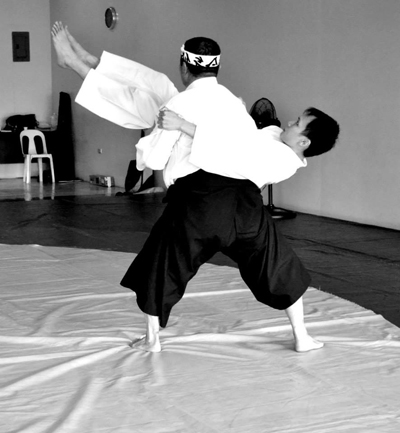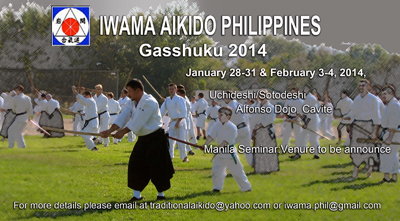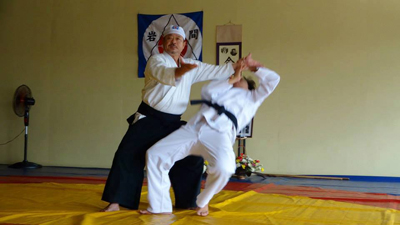 Traditional Aikido Philippines has had the fortune of having Saito Sensei visit us once again as part of our semi-annual seminar in Cebu on July 20 & 21 and in Manila on July 27 & 28, 2013. Below is the “blow by blow” account of the two participants Dennis and Wilson. But before we start reading their experience it is good to note that this is the first time in the Philippines that Iwama Style participants outnumbered non-Iwama participants. It showed on Saito Sensei’s face the feeling of satisfaction. It also showed on the techniques covered, there were a lot of advance techniques and variations. Whereas before, it will be more than an hour before we even move away from tai no henko and morete dori kokyuho. Now on the story.
Traditional Aikido Philippines has had the fortune of having Saito Sensei visit us once again as part of our semi-annual seminar in Cebu on July 20 & 21 and in Manila on July 27 & 28, 2013. Below is the “blow by blow” account of the two participants Dennis and Wilson. But before we start reading their experience it is good to note that this is the first time in the Philippines that Iwama Style participants outnumbered non-Iwama participants. It showed on Saito Sensei’s face the feeling of satisfaction. It also showed on the techniques covered, there were a lot of advance techniques and variations. Whereas before, it will be more than an hour before we even move away from tai no henko and morete dori kokyuho. Now on the story.
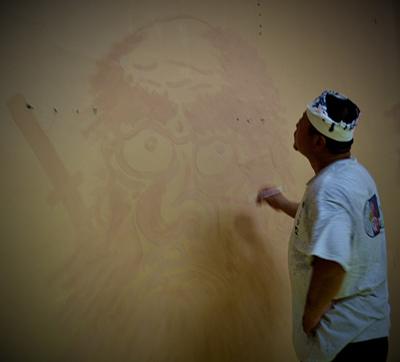 It was quite a momentous occasion in Cebu because the seminar coincided with the inauguration of the new Cebu dojo. We were able to witness how humble and skilled Saito Sensei can be. Since the dojo was still under construction when Saito Sensei arrived in Cebu, he dove right in and got his hands dirty. He did all sorts of dirty jobs like mopping, cleaning and even painted the walls. He personally instructed the local carpenters in building the kamiza for the new dojo. He even drew a “larger than life” painting of a “Daruma” on a wall, which helped give the dojo a very unique, Japanese touch. At first, we asked who or what he was drawing, he smiled and answered that it was a self-portrait. Since he used a paint that is slightly darker in hue of the wall paint, Saito Sensei jokingly said that it would be like a ghost that shall suddenly appear on the wall. This is because you can actually better see the drawing when most of the lights are turned off in the dojo. Then after he completed the drawing, Saito Sensei cracked another joke and said that it actually looked more like Dennis Tatoian Sensei since he was also sporting a beard. Finally, Saito Sensei also wrote a calligraphy bearing the name of the dojo, Cebu Iwama Aikido Ryu. As for the rest of us, we helped in the cleaning and the setting up of the mats.
It was quite a momentous occasion in Cebu because the seminar coincided with the inauguration of the new Cebu dojo. We were able to witness how humble and skilled Saito Sensei can be. Since the dojo was still under construction when Saito Sensei arrived in Cebu, he dove right in and got his hands dirty. He did all sorts of dirty jobs like mopping, cleaning and even painted the walls. He personally instructed the local carpenters in building the kamiza for the new dojo. He even drew a “larger than life” painting of a “Daruma” on a wall, which helped give the dojo a very unique, Japanese touch. At first, we asked who or what he was drawing, he smiled and answered that it was a self-portrait. Since he used a paint that is slightly darker in hue of the wall paint, Saito Sensei jokingly said that it would be like a ghost that shall suddenly appear on the wall. This is because you can actually better see the drawing when most of the lights are turned off in the dojo. Then after he completed the drawing, Saito Sensei cracked another joke and said that it actually looked more like Dennis Tatoian Sensei since he was also sporting a beard. Finally, Saito Sensei also wrote a calligraphy bearing the name of the dojo, Cebu Iwama Aikido Ryu. As for the rest of us, we helped in the cleaning and the setting up of the mats.
As soon as the final touches were made, an intense keiko ensued. Classes were a mixture of bukiwaza and taijutsu. Even though Saito Sensei can speak and relate to us in English, we were very lucky to have the presence of Dennis Tatoian Sensei to help with the Japanese translations. As with all taijutsu classes, we began with tai no henko and morote dori kokyu ho and afterwards he showed ninin dori morote . Most of us struggled with it. Saito Sensei patiently showed us how to do the technique properly and you can see “bulbs” lighting up all over our heads and smiles across our faces the moment we were able to execute it.
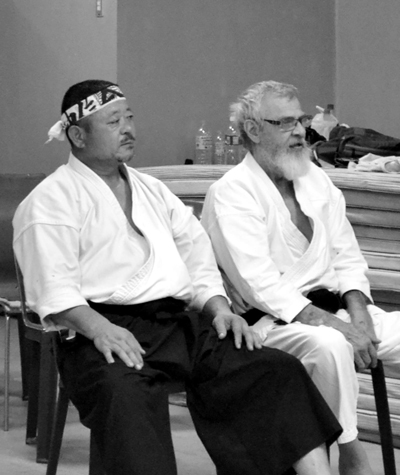 The highlight of the first day in the Cebu seminar was when we got the privilege to practice shuriken! We were all so pumped up that we had a hard time containing our excitement! Saito Sensei showed us the kata, how to handle the shuriken and how not to use force. It was the first time for most of us and with beginners luck, we were able to hit the target a few times. Excitement then slowly turned into frustration as our luck ran out. We couldn’t stick the shuriken into the target anymore. A sudden realization came to mind that it is not at all the same as in the movies. Throwing shuriken properly is not as easy as it looks. Additional pressure was upon us when the shuriken kept on clanging on the target and falling on the floor since both Saito Sensei and Tatoian Sensei were seated right beside us and watching really closely. They both patiently reminded us to relax, keep the form and not to be too eager. As with everything else, practice makes perfect. It was an awesome experience!
The highlight of the first day in the Cebu seminar was when we got the privilege to practice shuriken! We were all so pumped up that we had a hard time containing our excitement! Saito Sensei showed us the kata, how to handle the shuriken and how not to use force. It was the first time for most of us and with beginners luck, we were able to hit the target a few times. Excitement then slowly turned into frustration as our luck ran out. We couldn’t stick the shuriken into the target anymore. A sudden realization came to mind that it is not at all the same as in the movies. Throwing shuriken properly is not as easy as it looks. Additional pressure was upon us when the shuriken kept on clanging on the target and falling on the floor since both Saito Sensei and Tatoian Sensei were seated right beside us and watching really closely. They both patiently reminded us to relax, keep the form and not to be too eager. As with everything else, practice makes perfect. It was an awesome experience!
The following day started off with much anticipation. We were hoping that there would be more shuriken practice. Alas! We were not given such a treat. Nevertheless, we practiced taijutsu with much gusto in the morning. We practiced shomenuchi iriminage, katadori shihonage, and several ryokatadori kokyunage techniques.
In the afternoon, was a whole different scenario. We had bokken practice. We began with ken suburi # 1, 5, 6 & 7. Saito Sensei corrected us on our forms such as not to tilt the head when doing yokomenuchi or not to swing the ken too wide but to simply raise it up for more efficient and proper movement. Then we moved on to ken awase. Admittedly, it was our lack of proper practice so we kept on making various mistakes with our footwork and timing, which ticked off Sensei Saito. Consequently, Saito Sensei reprimanded us all. What’s worse was that the more we got scolded, the more mistakes we did which made Saito Sensei angrier. Our hearts were racing. Our knees were quaking that we could hardly stand upright. Our arms were growing limp that we had a hard time holding up the ken. It was like we couldn’t hear nor understand what Saito Sensei was telling us to do. Our minds were going blank. We were all panicking but trying so hard not to show it. But am pretty sure that we were doing that pretty badly as well. After what seemed like an eternity, we all calmed down and regained our composure. Then Saito Sensei showed us a couple of tachidori techniques. One of which is where the nage sidesteps and enters with the footwork similar to tai no henko then grabs uke’s bokken from the side and slashes or stabs the neck of uke and then throw to finish the technique. Whew! That was truly a night to remember!
Another quite interesting moment worth mentioning for this particular visit in Cebu was when Saito Sensei decided to stop by a local Catholic Church that was quite close to where the new dojo is located. He went inside, prayed and left a donation for the church. Probably sensing that we have questions brewing inside our heads, Saito Sensei said that all religions are the same… that they come from the same source. He said that he felt quite invigorated after the visit. In fact, he went back to the church and attended mass on Sunday. But he had to leave the mass early since it was already time for keiko.
The following weekend was time for the Manila leg of the seminar. Aside from the regular seminar schedule, Saito Sensei held a special class in the Alfonso Dojo in Tagaytay. For that day, we did taijutsu techniques concentrating mostly on ushiro eridori techniques such as ikkyo & various kokyunage. After keiko, we were surprised and honored that Saito Sensei asked us all to stay and have lunch with him. It was a simple lunch of spaghetti and burgers under a tree but it was a refreshing and novel experience to be able to share with everyone present.
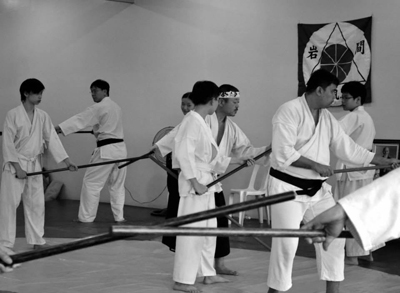 The Manila seminar was held at the Budokan Manila in Pasig. First half of the day, we mostly did katatetori and shomenuchi techniques. We did shihonage, kotegaeshi, iriminage, ikkyo and kokyunage from those attacks. Saito Sensei showed and reminded us the importance of atemi. Saito Sensei also pointed out the proper hand position of nage when executing shihonage, which is actually a common mistake for those of us who don’t know any better. There was even one technique where we applied nikkyo then switched to sankyo and finished with yonkyo all in one go. It really loosened up our wrists! Of course, we can’t do without taino henko, morote dori kokyunage and suwariwaza kokyuho as always. In the afternoon, we did the 31 jo kata and also half of the jo suburi. Saito Sensei was quite pleased to see how quickly the children were able to pick up on both taijutsu and bukiwaza techniques. Of course, they have so much more to learn and improve upon as those of us who are young at heart. 😉
The Manila seminar was held at the Budokan Manila in Pasig. First half of the day, we mostly did katatetori and shomenuchi techniques. We did shihonage, kotegaeshi, iriminage, ikkyo and kokyunage from those attacks. Saito Sensei showed and reminded us the importance of atemi. Saito Sensei also pointed out the proper hand position of nage when executing shihonage, which is actually a common mistake for those of us who don’t know any better. There was even one technique where we applied nikkyo then switched to sankyo and finished with yonkyo all in one go. It really loosened up our wrists! Of course, we can’t do without taino henko, morote dori kokyunage and suwariwaza kokyuho as always. In the afternoon, we did the 31 jo kata and also half of the jo suburi. Saito Sensei was quite pleased to see how quickly the children were able to pick up on both taijutsu and bukiwaza techniques. Of course, they have so much more to learn and improve upon as those of us who are young at heart. 😉
On the final day, even more people came. As always, Saito Sensei patiently guided us all through the techniques. Constantly reminding us to use proper footwork along with proper posture to make executing the techniques quite effortlessly… even for the children. The practice for the day was mostly ushiro ryokatadori techniques including several kokyunage, and ikkyo. One funny moment was when he asked us to do ushiro ryokatadori where Saito Sensei sidestepped and grabbed the uke’s hips and threw him down the straight to the mats with a loud thud. After showing the technique, all the kids got intimidated and made a resounding “Oh my god!” which elicited smiles and laughter from Sensei and rest of the adults. When the kids were able to execute it, you can see a satisfied smile on Saito Sensei and wide-eyed amazement on the kids’ faces.
Then at one point, noticing that some of us were having trouble throwing our partners properly with a particular kokyunage technique, it actually became the highlight of the day. Saito Sensei wanted to point out that it could be easily done and decided to demonstrate the technique on the biggest fellow in class who is the tallest and heaviest on the class. Saito Sensei did it a couple of times. He did it slowly and so effortlessly that we all stared with wide eyes and found our mouths agape after we felt the aftershock from the throws. Can’t imagine what it would have been like if the uke had been thrown at 100% power!
We continued with the latter half of the 20 jo suburi in the afternoon. For safety concerns, the class had to be divided into two groups to allow everyone to practice the jo movements more freely and properly. We then moved on to ichi no kumijo. Everyone enjoyed the bukiwaza immensely especially the children since they were actually allowed to strike and make contact with one another’s jo. There were variations shown and taught and as such, these added variations were a welcome challenge for all of us. For instance, the 19th & 20th jo suburi can actually be combined into one continuous movement.
By the end of the day, everyone was exhausted, yet were all wearing satisfied smiles. The seminar was quite a success due to the fact that there were so many lessons learned. Saito Sensei patiently guided us through the techniques especially with the kids. He continually encouraged them and praised them if and when they did the techniques correctly. There was a final surprise for all of us who didn’t immediately leave after class. Saito Sensei personally wrote the children’s names in hiragana on the sleeves of their gi. Since most of us were wearing the official Iwama Philippines t-shirt, Saito Sensei literally signed on the shirts off our backs! Cool!
Can’t wait for the Gasshukku this coming January 2014!

